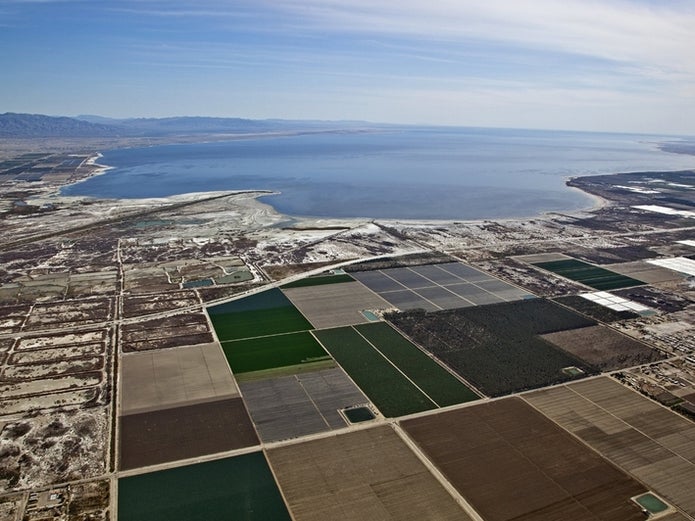
“During this earthquake swarm, the probability of larger earthquakes in this region is significantly greater than usual,” the USGS said.
By Toni McAllister, Patch Staff
|
RIVERSIDE COUNTY, CA — This week’s earthquake swarm, at the southern end of the San Andreas Fault near the Salton Sea, is a stark reminder that California residents and businesses are at risk, officials are warning.
“Earthquakes can happen at any time,” said Bruce Barton, director of the Riverside County Emergency Management Department. “It is important to remember that Southern California is earthquake country and Riverside County has active fault lines running through it. The time to prepare for earthquakes is now.”
The earthquake swarm began at 6:33 a.m. Monday in the Salton Sea region, and dozens of temblors have been reported since. Most are centered near Bombay Beach, along the Salton Sea’s eastern edge. The largest quake struck at 8:56 a.m. Monday and measured a magnitude 4.6, according to the U.S. Geological Society. Many of the quakes have registered well above 3.0.
The Salton Sea stretches across Riverside and Imperial counties, with the San Andreas Fault’s southern reach running along the water’s northwest shore.
The USGS issued a public statement in response to the earthquake swarm, noting that there is an 80 percent probability that earthquakes will continue over the next seven days and some may be moderate in size — magnitude 4.5 to 5.4.
There is approximately a 19 percent chance that a larger earthquake between magnitude 5.5 to 6.9 could occur within seven days, which could cause damage around the Salton Sea, as well as aftershocks. There is a 1 percent probability that a much larger earthquake — of magnitude 7 or higher — can occur within seven days, according to the statement.
“During this earthquake swarm, the probability of larger earthquakes in this region is significantly greater than usual,” the USGS statement read. “The southernmost section of the San Andreas Fault is capable of rupturing in large magnitude earthquakes (magnitude 7+), but the last earthquake that strong was more than 300 years ago.
“In a typical week, there is approximately a 1 in 10,000 chance of a magnitude 7+ earthquake on the southernmost San Andreas Fault. That probability is significantly elevated while swarm activity remains high,” the agency’s statement continued. “While this is a very small probability, if such an earthquake were to occur, it would have serious impacts on communities nearby and would be followed by aftershocks that would increase the number of smaller earthquakes per day.”
Scientists were looking at how far away from the San Andreas Fault the swarm was in determining how likely it is that a “big one” will hit. The quake sequence has been about 7.5 miles away from the San Andreas Fault’s southern reach, seismologist Lucy Jones told the Los Angeles Times. “So this is probably too far away,” she said, for the swarm to trigger a large one on the San Andreas. “It’s not so much too far away that you say it’s impossible. But probably too far away.”
Riverside County officials are advising residents, business owners and visitors to plan ahead for any scenario. They advise:
Now: Create an emergency kit with water, food and other essential items that will sustain your family for three to seven days.
During: Drop, cover and hold on during the shaking. If driving, pull to the side of road and stop until shaking stops. Do not take cover under overpasses or bridges.
After: Prepare for aftershocks. Do not handle or drive over downed power lines. If you smell gas, leave the area.
“This latest swarm of earthquakes reminds me of words from my former UC Riverside geography professor. He told us students, ‘This is earthquake country. It is only a matter of time for a major earthquake.’ We should always be prepared,” said Riverside County Board Chair V. Manuel Perez, Fourth District Supervisor.
Riverside County residents are urged to register cell phone numbers with the county’s mass notification system, called Alert RivCo, which will notify residents of an earthquake. Most California county’s have a similar system.
Additionally, California has an early warning system called “MyShake,” the nation’s first statewide Earthquake Early Warning System. On Monday, Gov. Gavin Newsom announced in partnership with Google, that the forthcoming update to the company’s Android operating system will incorporate the technology into all Android phones.
Last October, on the 30th anniversary of the deadly Loma Prieta earthquake in Northern California, Newsom unveiled MyShake. The technology provides advance warning before the ground starts to shake from a nearby quake — enough time to drop, cover and hold on to help prevent injury.
Warnings delivered through the system are based on ShakeAlert technology operated by the Governor’s Office of Emergency Services and the USGS. The system analyzes data from seismic networks in California, calculates preliminary magnitudes, and then estimates which areas will feel shaking.
To download the MyShake application, visit: www.earthquake.ca.gov.
Source: Los Angeles Patch